Aging Characteristics of Rubber Modified Asphalts in Different Environmental Factors Combinations
Abstract
:1. Introduction
2. Materials and Methods
2.1. Preparation Technology
2.2. Test Scheme
2.2.1. Environmental Combinations
Unaged Stage (Referred to as A)
Short-Term Thermal Oxidative Aging (Referred to as B)
Thermal Oxygen and Ultraviolet Aging (Referred to as C)
Long-Term Thermal Oxidative Aging (Referred to as D)
Thermal Oxygen and Water Aging (Referred to as E)
Thermal Oxygen, Water, and Ultraviolet Aging (Referred to as F)
2.2.2. Test Methods for Property Characterization
Tests for Technical Indices
Tests for Chemical Indices
3. Results and Discussion
3.1. Evaluation Index for Aging Characteristics
3.2. Technical Indices Analysis
3.2.1. Softening Point Analysis
3.2.2. Viscosity Analysis
3.2.3. Creep Stiffness and Creep Rate Analyses
3.2.4. Fatigue Cracking Factor () Analysis
3.3. Chemical Indices Analyses
3.3.1. SEM Analysis
3.3.2. Thermogravimetric Analysis
3.3.3. IR Spectrum Analysis
4. Conclusions
- (1)
- Conventional property tests, including softening point, viscosity, creep stiffness, creep rate, and fatigue cracking factor, were conducted on asphalt samples. Results demonstrate that the aging characteristics of two kinds of rubber-modified asphalts improve with different pertinences, unlike virgin asphalt. Firstly, the resistant ability to high temperature of asphalt rubber rarely declines under water molecule action, whereas TOR asphalt rubber effectively avoids the degradation in resistance to high temperature induced by ultraviolet radiation. Secondly, the low-temperature resistance of asphalt rubber remains relatively stable under either water action or air pressure. Thirdly, asphalt rubber has superior resistance to traffic loading under ultraviolet radiation. In addition, TOR asphalt rubber has strong resistance to traffic loading in a water environment.
- (2)
- Chemical analyses contribute to the determination of aging mechanism. The SEM images illustrate that the detrimental effects of multi-factor combinations lead to the rough surfaces of two kinds of rubber modified asphalts, and these correspond directly to asphalt decays. According to thermogravimetric analysis, the good thermal stability of three kinds of asphalts are confirmed by the similar TG curves observed in most environmental combinations. Based on the IR spectra, new characteristic functional groups are not detected during the different aging processes. Furthermore, the oxidation degrees of two kinds of asphalt rubbers change relatively slightly throughout each aging process, thus demonstrating the outstanding antioxidant properties of them.
- (3)
- Lastly, aging characteristics in different environments can be reasonably considered in the rational application of asphalts. Asphalt rubber is suitable for hot and humid areas or low temperature areas, meanwhile TOR asphalt rubber is appropriate to intensive ultraviolet radiation regions and heavy traffic areas.
Acknowledgments
Author Contributions
Conflicts of Interest
References
- Yildirim, Y. Polymer modified asphalt binders. Constr. Build. Mater. 2007, 21, 66–72. [Google Scholar] [CrossRef]
- Liang, M.; Xin, X.; Fan, W.; Sun, H.; Yao, Y.; Xing, B. Viscous properties, storage stability and their relationships with microstructure of tire scrap rubber modified asphalt. Constr. Build. Mater. 2015, 74, 124–131. [Google Scholar] [CrossRef]
- Soon-Jae, L.; Akisetty, C.K.; Amirkhanian, S.N. The effect of crumb rubber modifier (CRM) on the performance properties of rubberized binders in HMA pavements. Constr. Build. Mater. 2008, 22, 1368–1376. [Google Scholar] [CrossRef]
- Wang, H.; You, Z.; Mills-Beale, J.; Hao, P. Laboratory evaluation on high temperature viscosity and low temperature stiffness of asphalt binder with high percent scrap tire rubber. Constr. Build. Mater. 2012, 26, 583–590. [Google Scholar] [CrossRef]
- Liu, H.; Chen, Z.; Wang, W.; Wang, H.; Hao, P. Investigation of the rheological modification mechanism of crumb rubber modified asphalt (CRMA) containing TOR additive. Constr. Build. Mater. 2014, 67, 225–233. [Google Scholar] [CrossRef]
- Ma, A. Research on Performance and cross Blend Mechanism of Microwave Radiant Crumb Rubber Modified Asphalt. Master’s Thesis, Yangzhou University, Yangzhou, China, 2006. [Google Scholar]
- Huang, Y.; Bird, R.N.; Heidrich, O. A review of the use of recycled solid waste materials in asphalt pavements. Resour. Conserv. Recycl. 2007, 52, 58–73. [Google Scholar] [CrossRef]
- Lu, X.; Isacsson, U. Effect of ageing on bitumen chemistry and rheology. Constr. Build. Mater. 2002, 16, 15–22. [Google Scholar] [CrossRef]
- Siddiqui, M.N.; Ali, M.F. Studies on the aging behavior of the Arabian asphalts. Fuel 1999, 78, 1005–1015. [Google Scholar] [CrossRef]
- Lin, J.; Hong, J.; Liu, J.; Wu, S. Investigation on physical and chemical parameters to predict long-term aging of asphalt binder. Constr. Build. Mater. 2016, 122, 753–759. [Google Scholar] [CrossRef]
- Calabi-Floody, A.; Thenoux, G. Controlling asphalt aging by inclusion of byproducts from red wine industry. Constr. Build. Mater. 2012, 28, 616–623. [Google Scholar] [CrossRef]
- Apeagyei, A.K. Laboratory evaluation of antioxidants for asphalt binders. Constr. Build. Mater. 2011, 25, 47–53. [Google Scholar] [CrossRef]
- Wang, J. Study on Ageing Mechanism and Rheologic Behavior of Asphalt under Simulate Ultraviolet Environment; Harbin Institute of Technology: Harbin, China, 2008. [Google Scholar]
- Zeng, W.; Wu, S.; Wen, J.; Chen, Z. The temperature effects in aging index of asphalt during UV aging process. Constr. Build. Mater. 2015, 93, 1125–1131. [Google Scholar] [CrossRef]
- Lv, W. Design Principle and Method of Asphalt Mixture, 1st ed.; Tongji University Press: Shanghai, China, 2001; pp. 40–43. ISBN 7560822266. [Google Scholar]
- Standard Test Methods of Bitumen and Bituminous Mixtures for Highway Engineering (JTG E20-2011); China Communications Press: Beijing, China, 2011; ISBN 9787114094682.
- Li, P.; Zhang, Z.; Wang, B. Discussion on UV-light ageing characteristic and mechanism of asphalt. J. Zhengzhou Univ. Eng. Sci. 2008, 29, 96–100. [Google Scholar] [CrossRef]
- Wu, S.; Pang, L.; Mo, L.; Qiu, J.; Zhu, G.; Xiao, Y. UV and thermal aging of pure bitumen-comparison between laboratory simulation and natural exposure aging. Road Mater. Pavement Des. 2008, 9, 103–113. [Google Scholar] [CrossRef]
- Yamaguchi, K.; Sasaki, I.; Meiarashi, S. Photodegradation test of asphalt binder using pressed thin film samples. Can. J. Civ. Eng. 2005, 32, 1166–1169. [Google Scholar] [CrossRef]
- Bian, F.; Zhao, Y.; Huang, X.; Wang, Z. Experimental study of water aging on asphalt during service life of pavements. J. Southeast Univ. Engl. Ed. 2010, 26, 618–621. [Google Scholar] [CrossRef]
- Solaimanian, M.; Anderson, D.; Hunter, D. Evaluation of Vestenamer Reactive Modifier in Crumb Rubber Asphalt; Pennsylvania Transportation Institute: Bellefonte, PA, USA, 2003. [Google Scholar]
- Yin, J.; Tan, J. The observation and analysis of the surface solar ultraviolet radiation in Shanghai. J. Trop. Meteorol. 2006, 22, 86–90. [Google Scholar] [CrossRef]
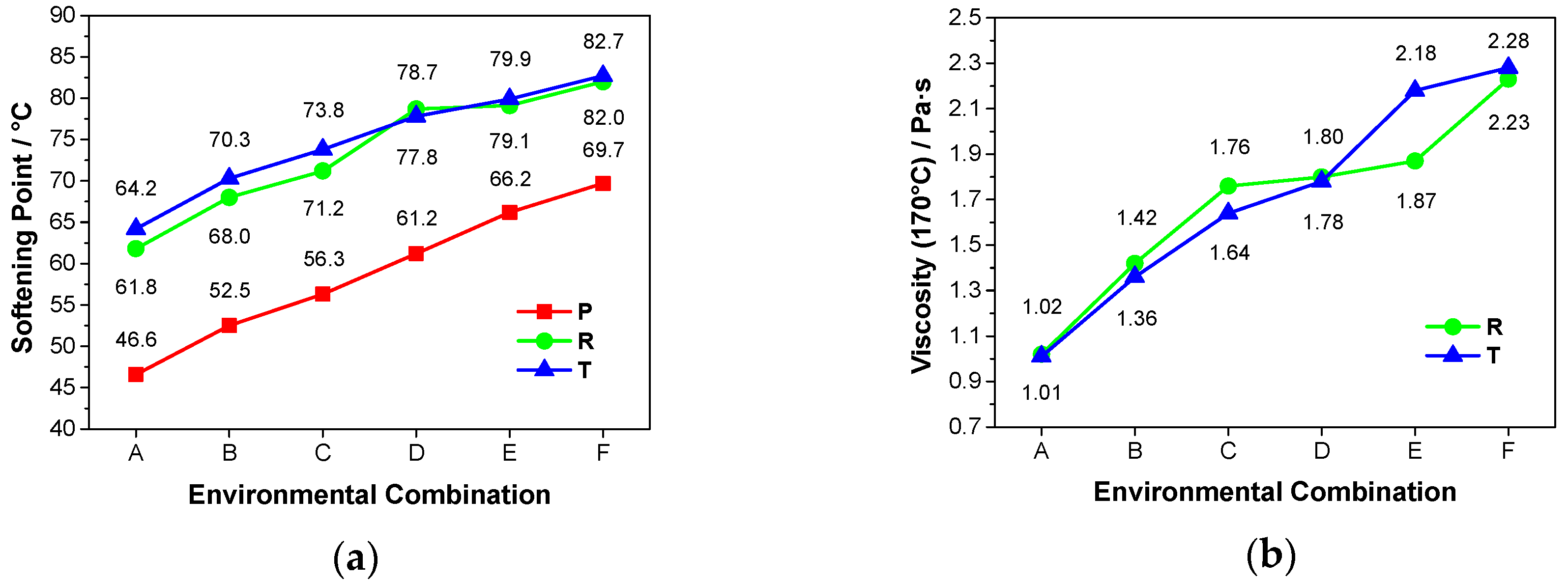

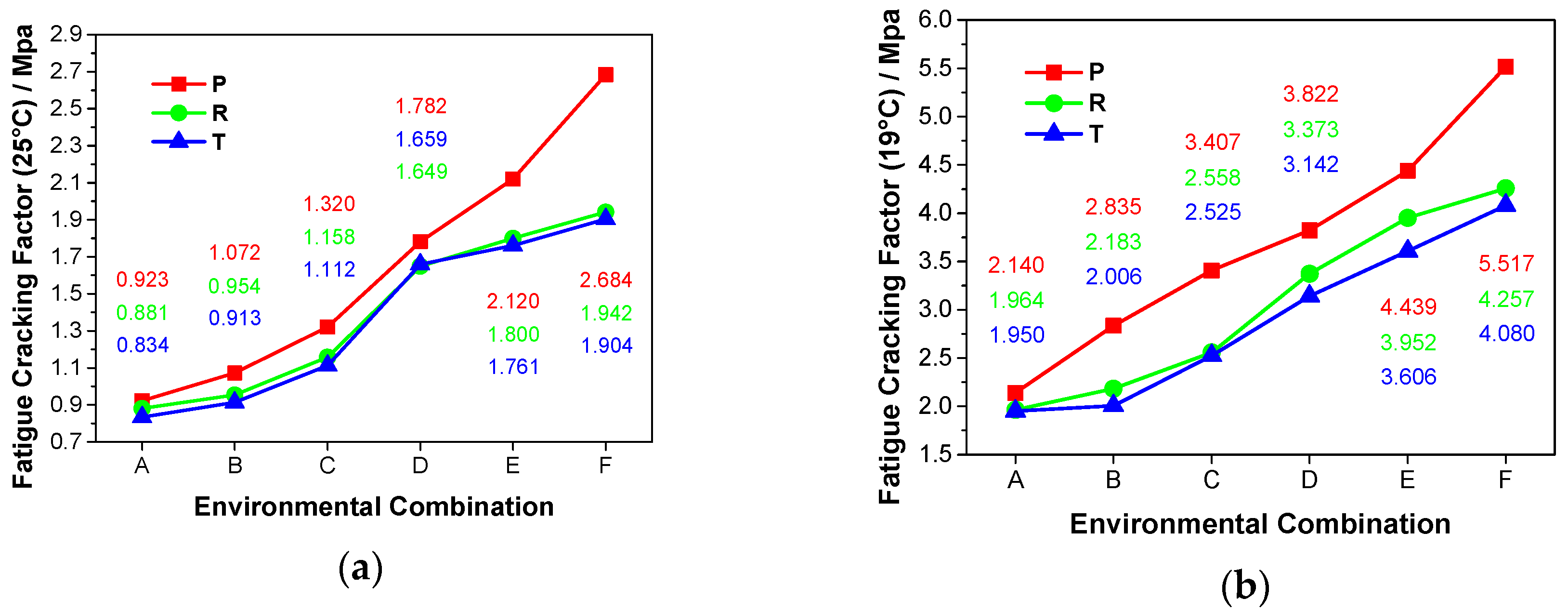
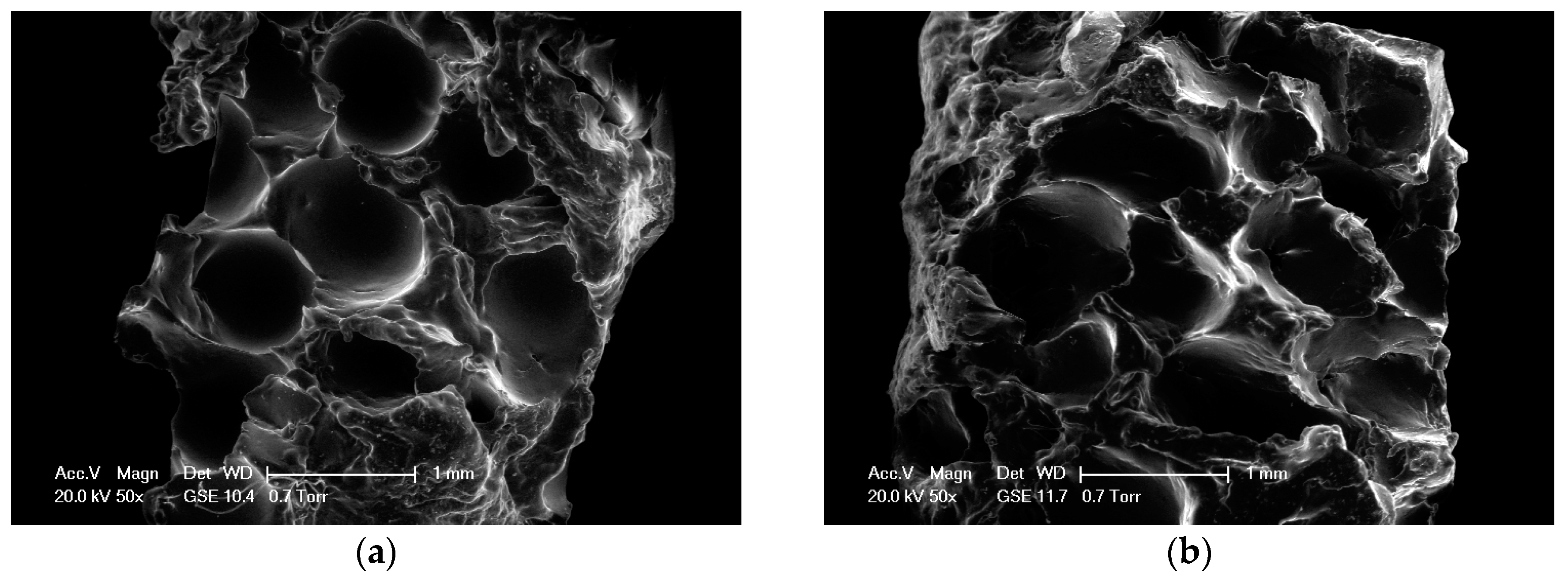
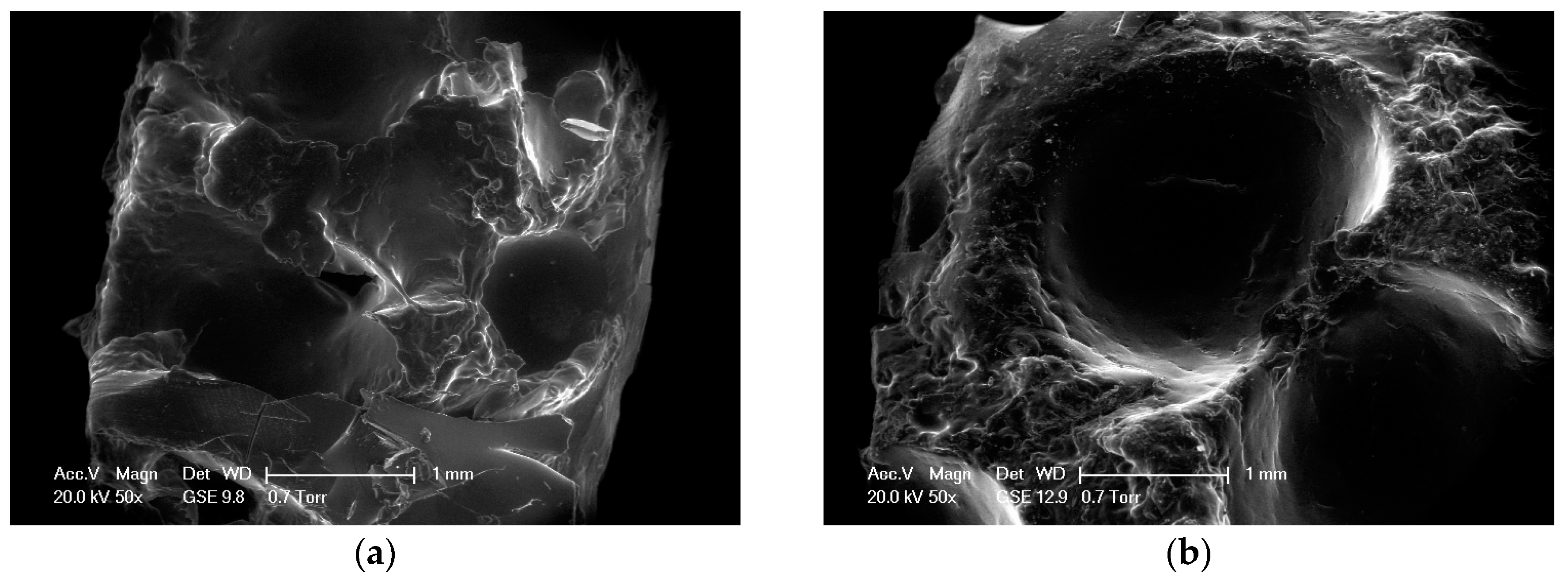
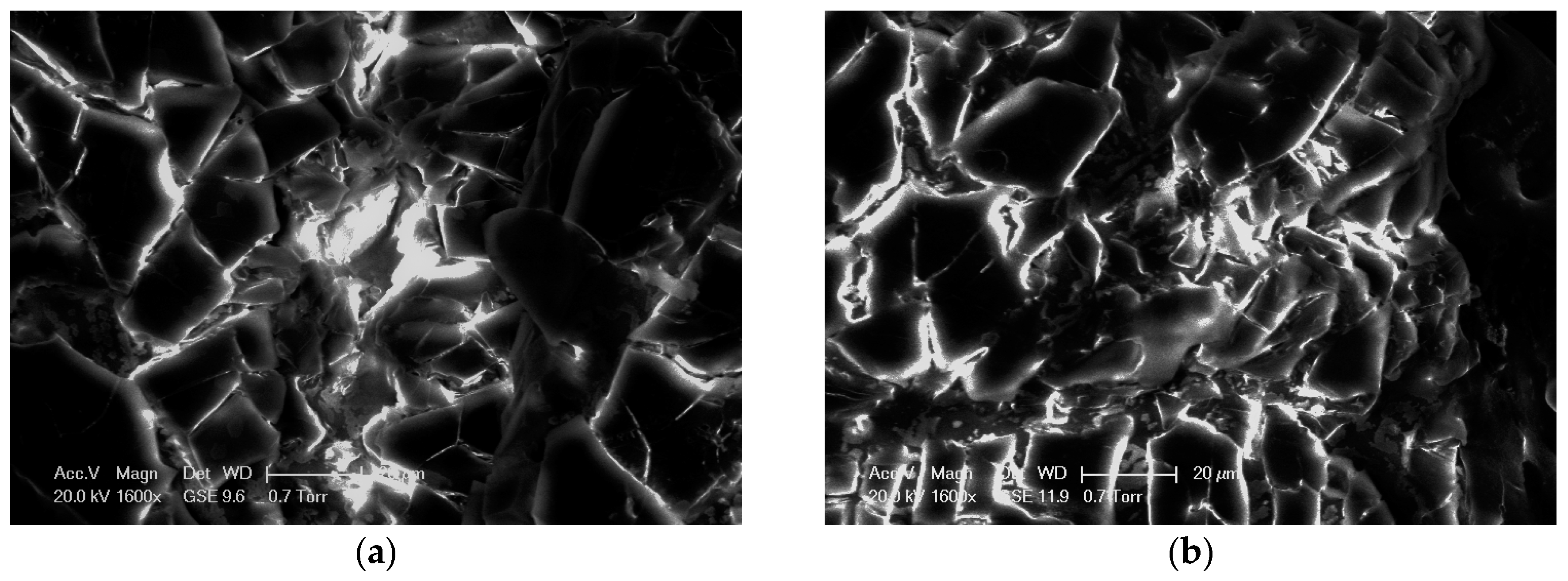
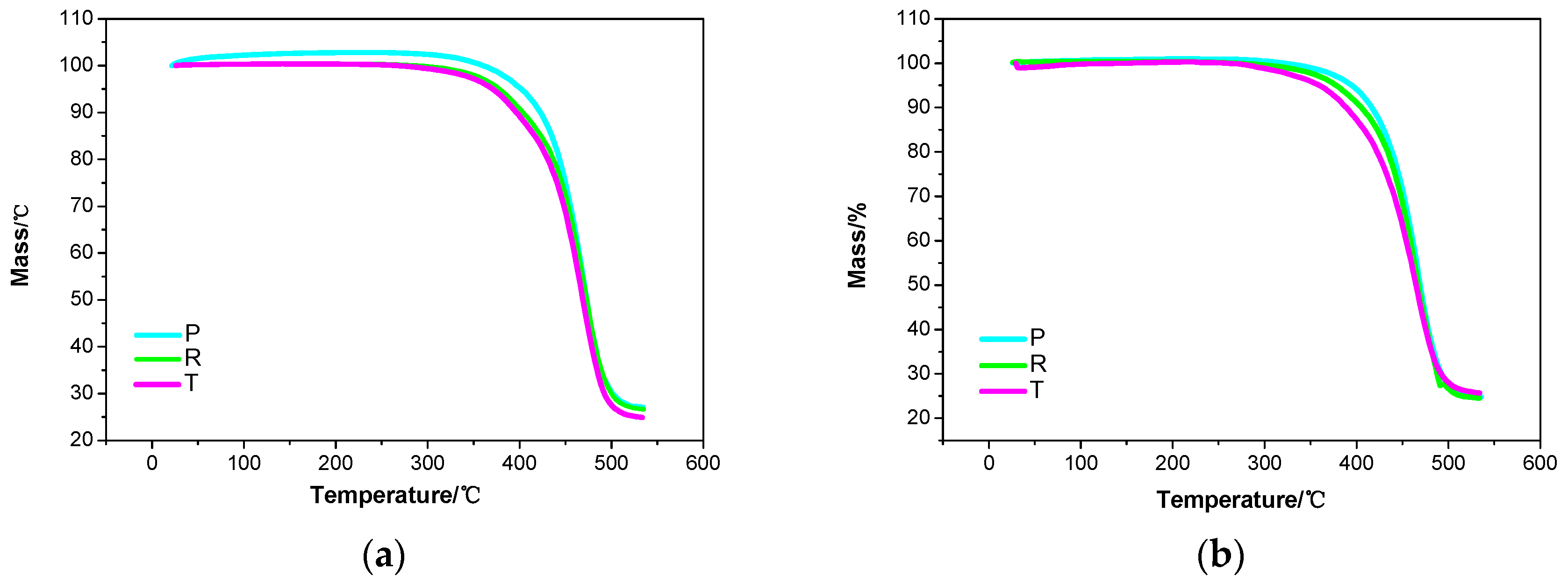
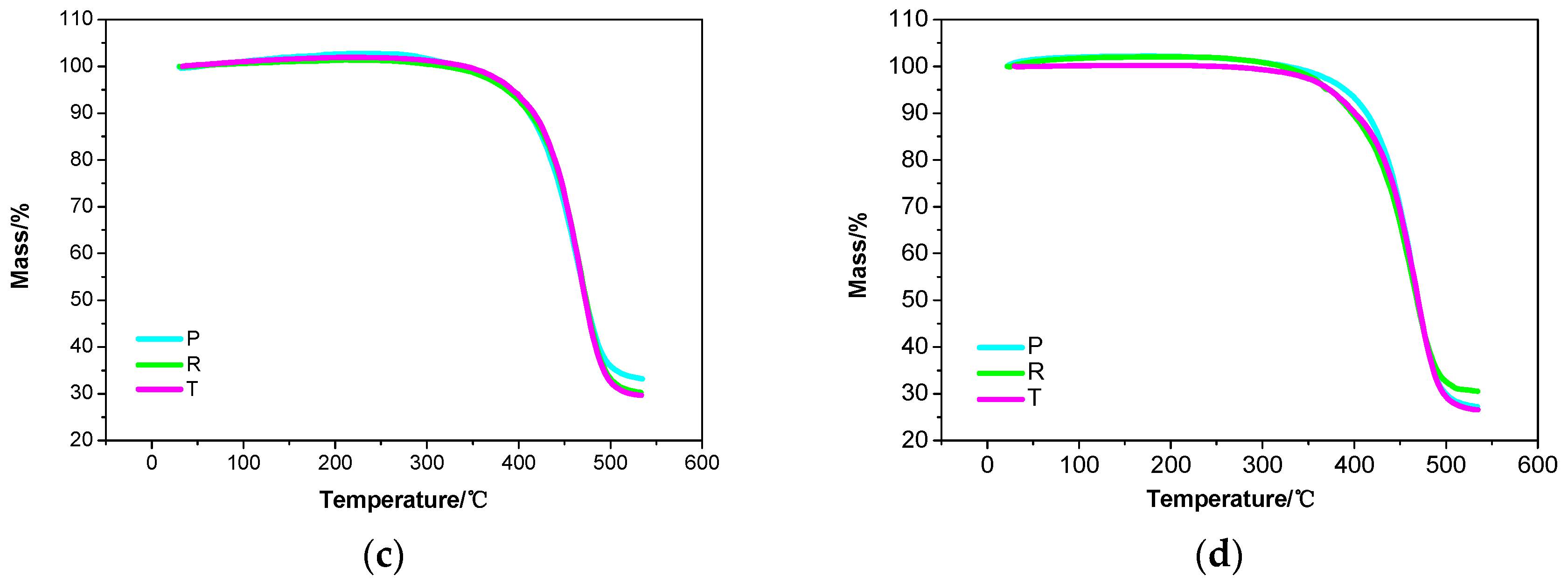
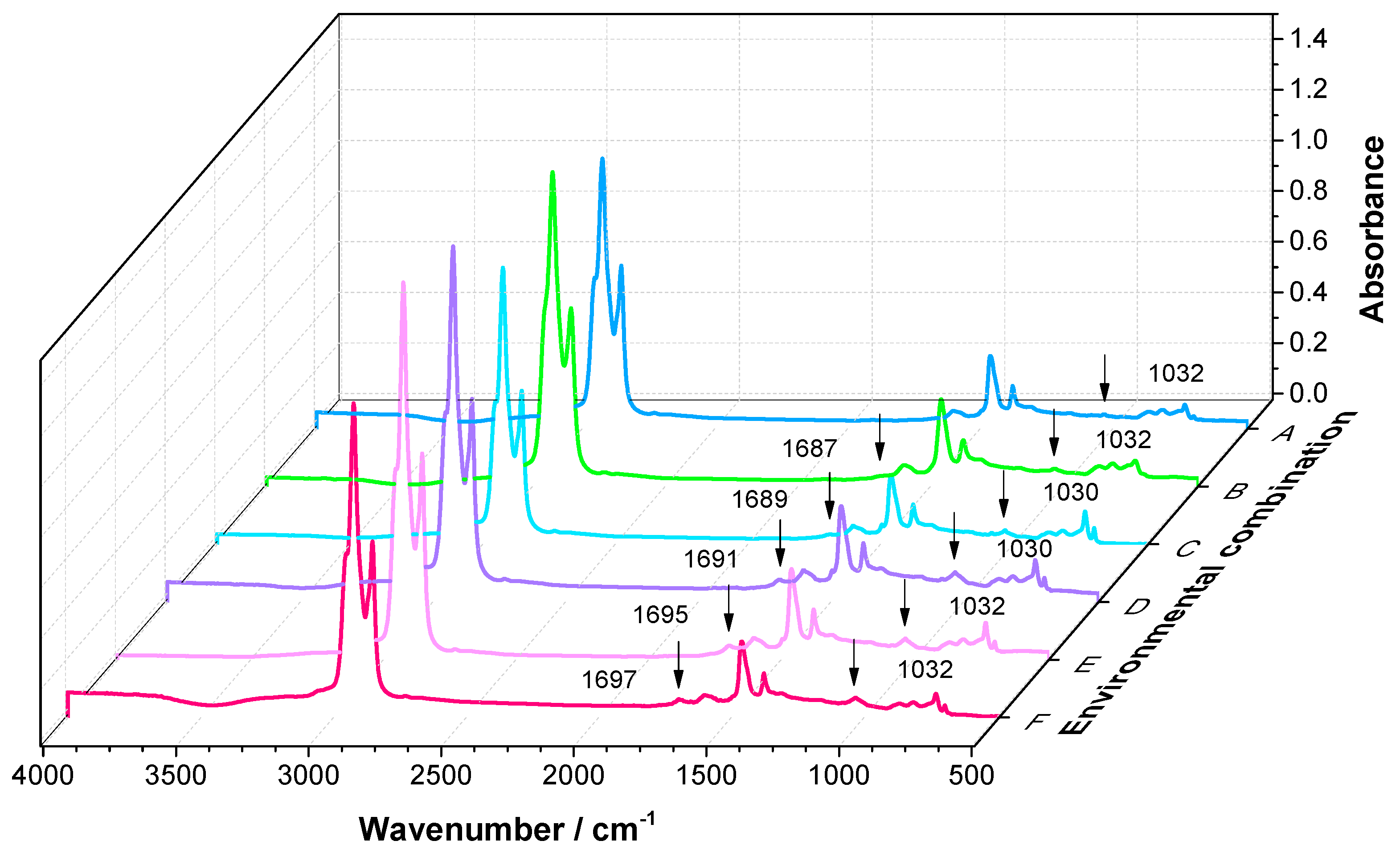
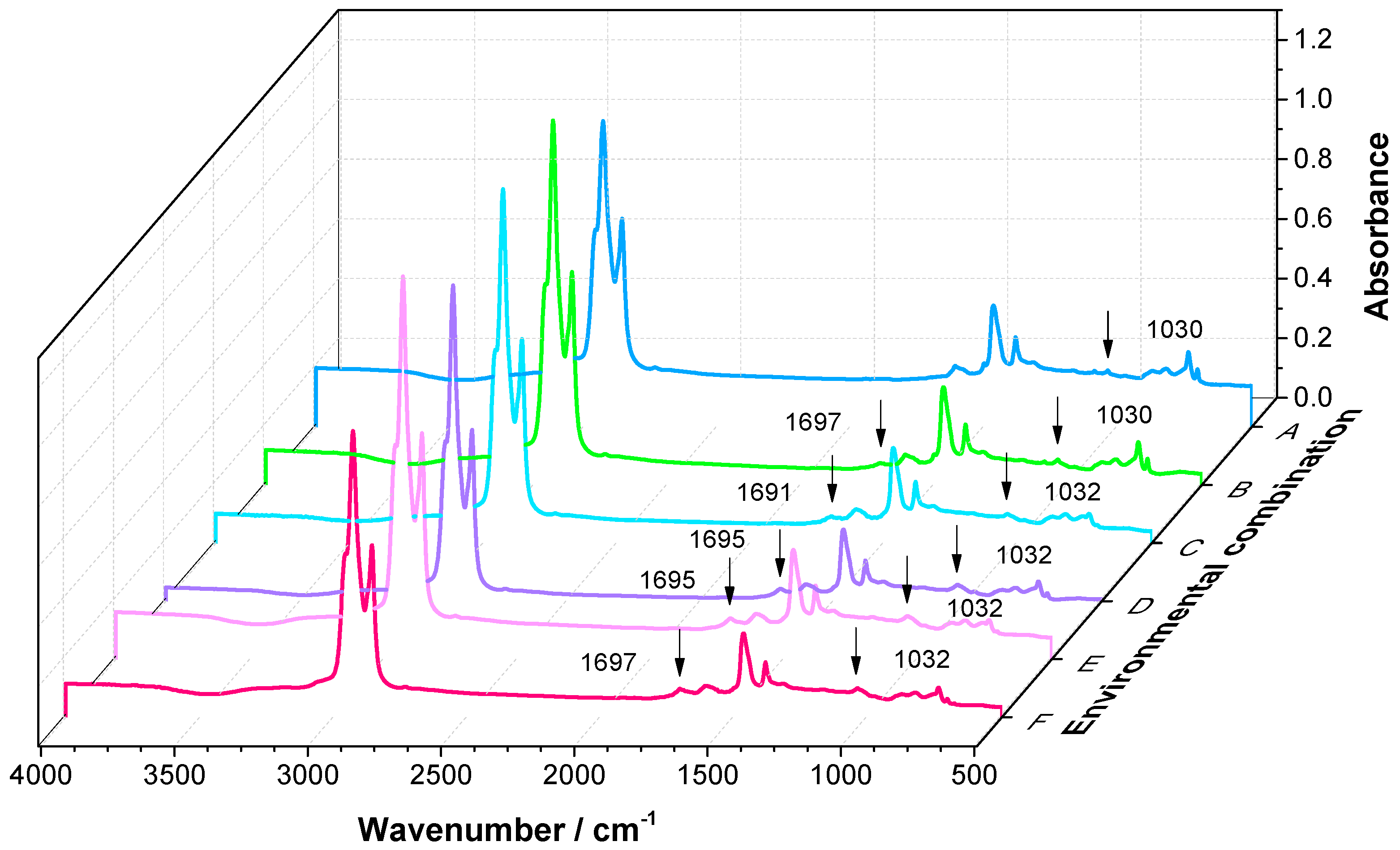
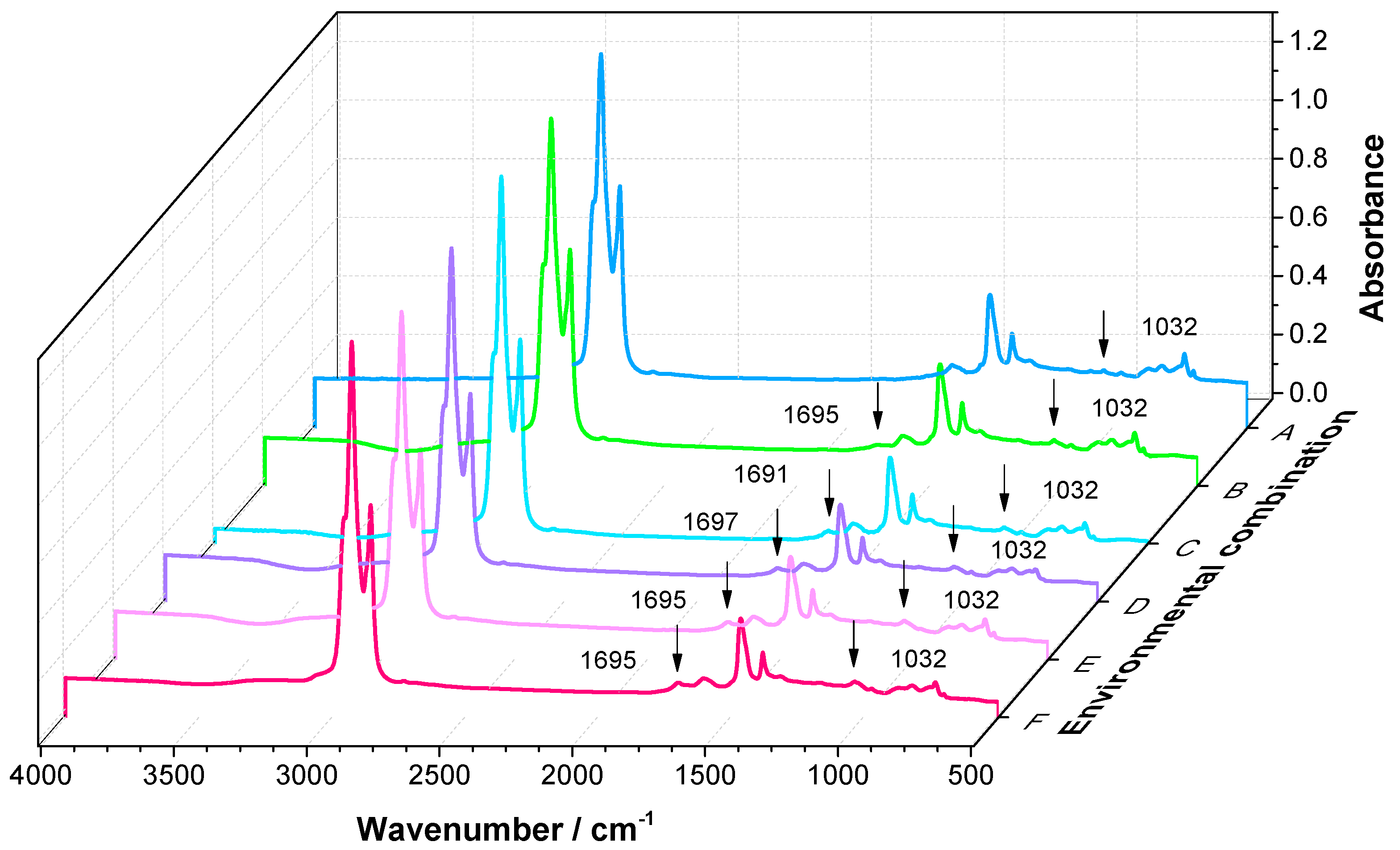
| Parameters | Standard Requirements | Results |
|---|---|---|
| Penetration/0.1 mm | 60~80 | 74 |
| Softening point/°C | ≮45 | 46.6 |
| Ductility (10 °C)/cm | ≮15 | 39 |
| Ductility (15 °C)/cm | ≮100 | >150 |
| Sequence Number | Aging Conditions |
|---|---|
| Condition A (Unaged stage) | - |
| Condition B (Short-term thermal oxidative aging) | 163 °C |
| 5 h | |
| Condition C (Thermal oxygen and ultraviolet aging) | 40 °C |
| 28 h | |
| Condition D (Long-term thermal oxidative aging) | 100 °C |
| 20 h | |
| 2.1 Mpa | |
| Condition E (Thermal oxygen and water aging) | 400 m (with water) |
| 800 m (without water) | |
| 100 °C, 2.1 Mpa | |
| Condition F (Thermal oxygen, water and ultraviolet aging) | Water aging |
| ultraviolet aging |
| Indices | Test Methods |
|---|---|
| Technical indices | Softening point |
| Viscosity | |
| Creep stiffness | |
| Creep rate | |
| Fatigue cracking factor | |
| Chemical indices | SEM analysis |
| Thermogravimetric analysis | |
| IR spectrum analysis |
| Combination and Factor | ||||
|---|---|---|---|---|
| B: short-term TO | C−B Adaptability to UR | D−B Adaptability to long-term (TO + AP) | E−D Adaptability to WM | F−E Adaptability to UR |
| C: short-term TO + UR | ||||
| D: short-term TO + long-term (TO + AP) | ||||
| E: short-term TO + long-term (TO + AP) + WM | ||||
| F: short-term TO + long-term (TO + AP) + WM + UR |
| Sample | |||||||||
|---|---|---|---|---|---|---|---|---|---|
| Asphalt P | 0.1266 | 0.2082 | 0.3133 | 0.4206 | 0.4957 | 0.0815 | 0.3133 | 0.1073 | 0.0751 |
| Asphalt R | 0.1003 | 0.1521 | 0.2735 | 0.2799 | 0.3269 | 0.0518 | 0.2735 | 0.0065 | 0.0469 |
| Asphalt T | 0.0950 | 0.1495 | 0.2118 | 0.2445 | 0.2882 | 0.0545 | 0.2118 | 0.0327 | 0.0436 |
| Sample | |||||||||
|---|---|---|---|---|---|---|---|---|---|
| Asphalt R | 0.3922 | 0.7255 | 0.7647 | 0.8333 | 1.1863 | 0.3333 | 0.7647 | 0.0686 | 0.3529 |
| Asphalt T | 0.3465 | 0.6238 | 0.7624 | 1.1584 | 1.2574 | 0.2772 | 0.7624 | 0.3960 | 0.0990 |
| Indices | Sample | |||||||||
|---|---|---|---|---|---|---|---|---|---|---|
| Creep stiffness | Asphalt P | 0.2621 | 0.3107 | 0.4757 | 0.5825 | 0.7282 | 0.0485 | 0.4757 | 0.1068 | 0.1456 |
| Asphalt R | 0.0046 | 0.0509 | 0.1991 | 0.2346 | 0.3287 | 0.0463 | 0.1991 | 0.0355 | 0.0941 | |
| Asphalt T | 0.0405 | 0.1699 | 0.4768 | 0.5502 | 0.6390 | 0.1293 | 0.4768 | 0.0734 | 0.0888 | |
| Creep rate | Asphalt P | 0.1502 | 0.1708 | 0.2654 | 0.2901 | 0.3169 | 0.0206 | 0.2654 | 0.0247 | 0.0268 |
| Asphalt R | 0.0184 | 0.0500 | 0.1290 | 0.1579 | 0.1842 | 0.0316 | 0.1290 | 0.0290 | 0.0263 | |
| Asphalt T | 0.0477 | 0.0854 | 0.1508 | 0.2060 | 0.2236 | 0.0377 | 0.1508 | 0.0553 | 0.0176 |
| Temperature | Sample | |||||||||
|---|---|---|---|---|---|---|---|---|---|---|
| 25 °C | Asphalt P | 0.1614 | 0.4301 | 0.9307 | 1.2969 | 1.9079 | 0.2687 | 0.9307 | 0.3662 | 0.6111 |
| Asphalt R | 0.0829 | 0.3144 | 0.8717 | 1.0431 | 1.2043 | 0.2316 | 0.8717 | 0.1714 | 0.1612 | |
| Asphalt T | 0.0947 | 0.3333 | 0.9892 | 1.1115 | 1.2830 | 0.2386 | 0.9892 | 0.1223 | 0.1715 | |
| 19 °C | Asphalt P | 0.3248 | 0.5921 | 0.7860 | 1.0743 | 1.5780 | 0.2673 | 0.7860 | 0.2883 | 0.5037 |
| Asphalt R | 0.1115 | 0.3024 | 0.7174 | 1.0122 | 1.1675 | 0.1909 | 0.7174 | 0.2948 | 0.1553 | |
| Asphalt T | 0.0287 | 0.2949 | 0.6113 | 0.8492 | 1.0923 | 0.2662 | 0.6113 | 0.2379 | 0.2431 |
| Sample | Index | A | B | C | D | E | F |
|---|---|---|---|---|---|---|---|
| Asphalt P | 0 | 0.018289 | 0.031278 | 0.070536 | 0.082277 | 0.095618 | |
| 0.024649 | 0.043078 | 0.088656 | 0.150342 | 0.131924 | 0.141804 | ||
| Asphalt R | 0 | 0.051451 | 0.071577 | 0.096944 | 0.111945 | 0.128721 | |
| 0.041658 | 0.073521 | 0.075599 | 0.126110 | 0.115765 | 0.124667 | ||
| Asphalt T | 0 | 0.046519 | 0.070505 | 0.090220 | 0.098583 | 0.109545 | |
| 0.036079 | 0.072126 | 0.073580 | 0.093736 | 0.099961 | 0.114495 |
© 2017 by the authors. Licensee MDPI, Basel, Switzerland. This article is an open access article distributed under the terms and conditions of the Creative Commons Attribution (CC BY) license (http://creativecommons.org/licenses/by/4.0/).
Share and Cite
Xiao, P.; Zheng, J.; Kang, A.; Sun, L.; Wang, Y. Aging Characteristics of Rubber Modified Asphalts in Different Environmental Factors Combinations. Appl. Sci. 2017, 7, 806. https://doi.org/10.3390/app7080806
Xiao P, Zheng J, Kang A, Sun L, Wang Y. Aging Characteristics of Rubber Modified Asphalts in Different Environmental Factors Combinations. Applied Sciences. 2017; 7(8):806. https://doi.org/10.3390/app7080806
Chicago/Turabian StyleXiao, Peng, Jiahui Zheng, Aihong Kang, Lu Sun, and Yingqian Wang. 2017. "Aging Characteristics of Rubber Modified Asphalts in Different Environmental Factors Combinations" Applied Sciences 7, no. 8: 806. https://doi.org/10.3390/app7080806




